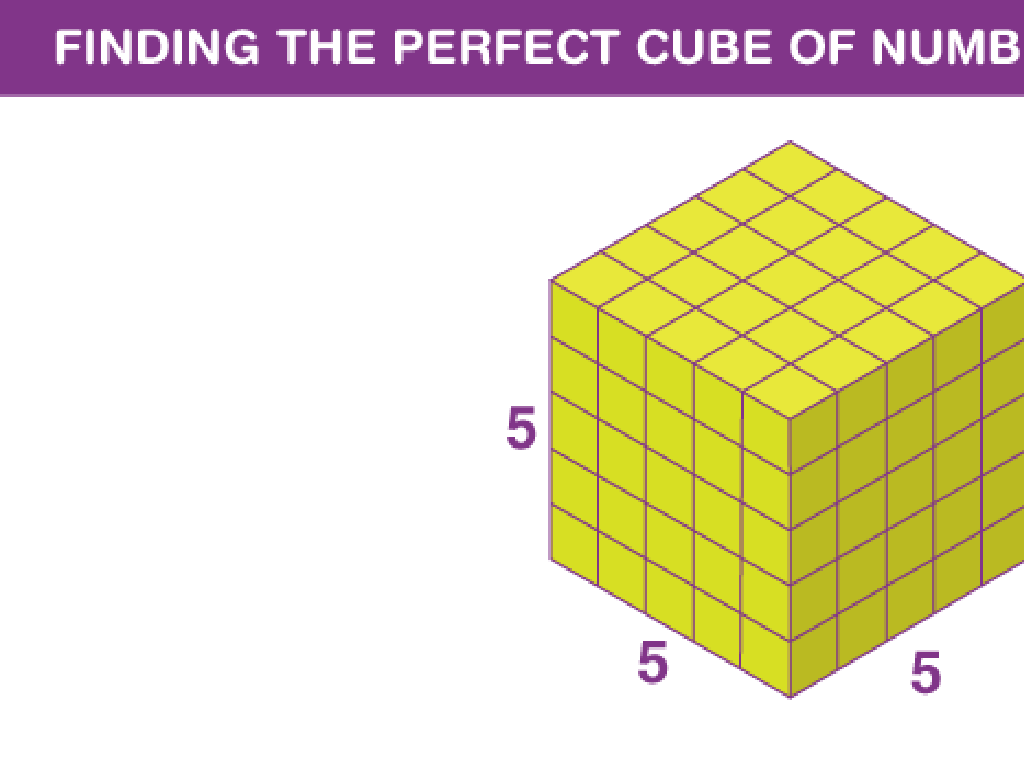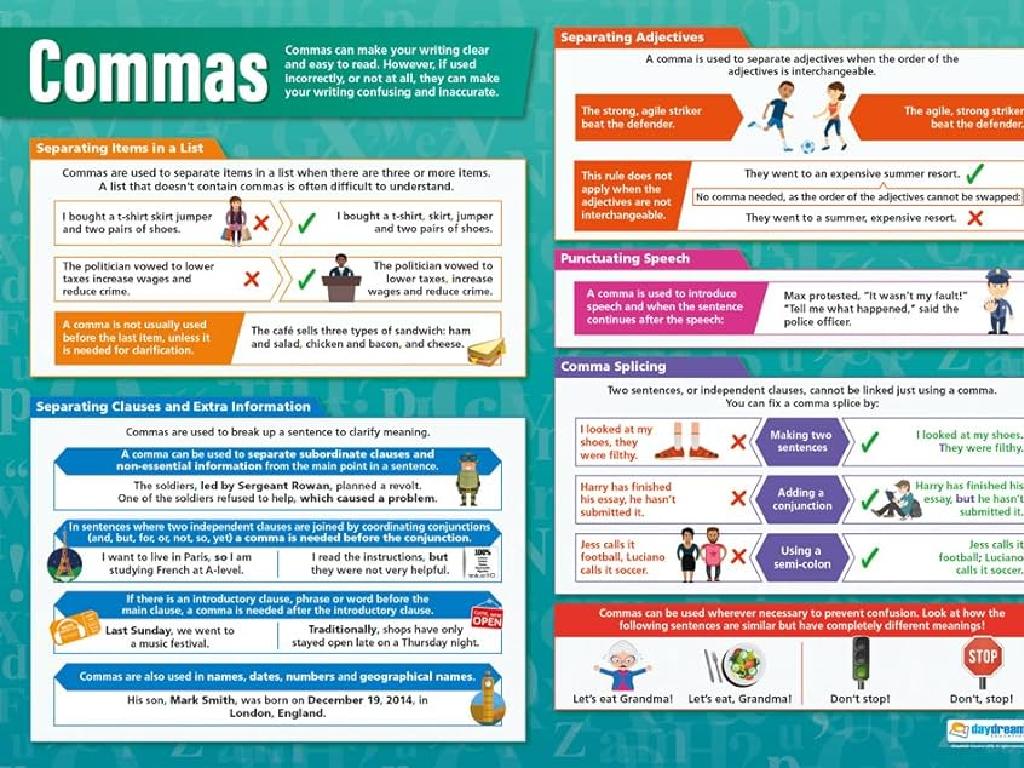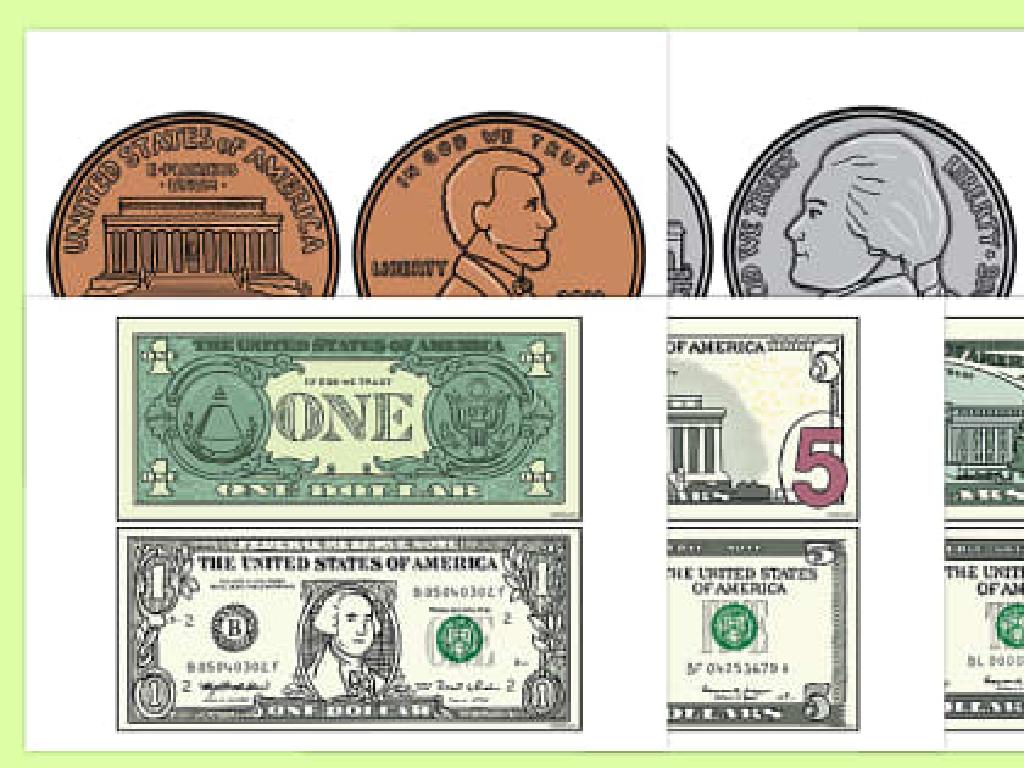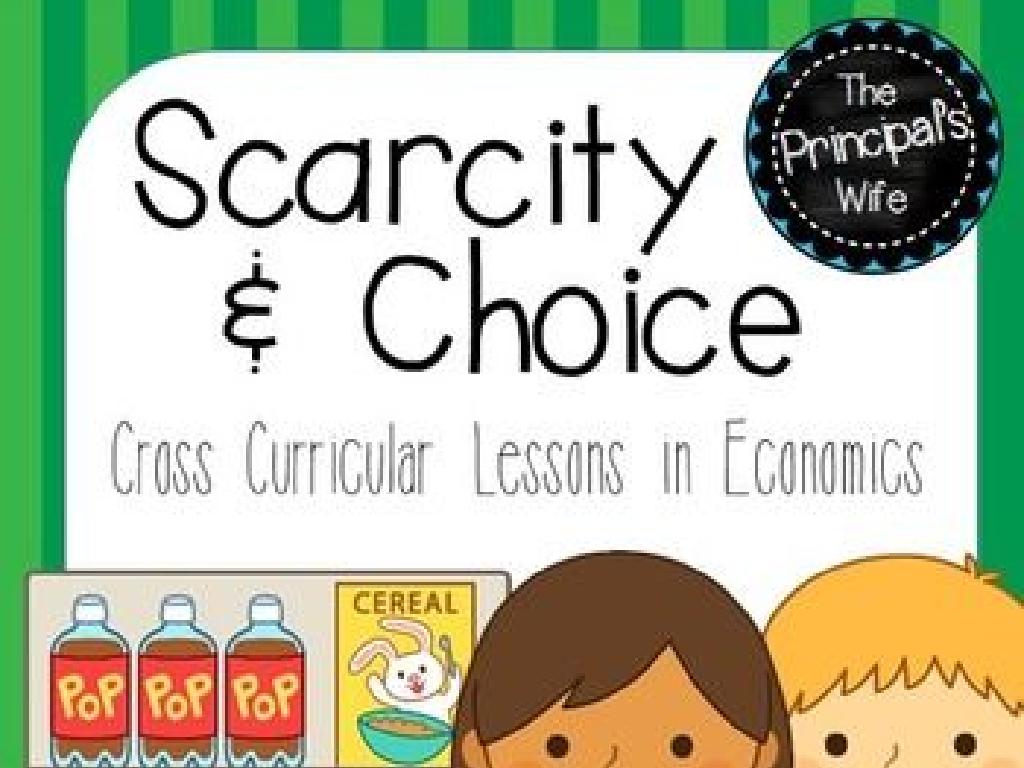Multiplication Word Problems With Factors Up To 10
Subject: Math
Grade: Third grade
Topic: Multiplication Word Problems
Please LOG IN to download the presentation. Access is available to registered users only.
View More Content
Welcome to Multiplication!
– Today’s focus: Word Problems!
– Multiplication as groups of numbers
– Imagine you have 4 bags with 5 apples each, multiplication helps you find the total apples.
– Why is multiplication a super skill?
– It helps quickly find totals and is used in many areas of life, like shopping or organizing events.
– Practice with real-life examples
– If you buy 3 packs of stickers with 10 in each, how many stickers do you have in all?
|
This slide introduces students to the concept of multiplication as a method for quick and efficient counting. It emphasizes the importance of multiplication in everyday life and sets the stage for students to solve word problems. The slide encourages students to think of multiplication as grouping numbers and to recognize its value as a fundamental math skill. Provide examples that relate to their experiences, such as buying multiple items or grouping objects. In the next class, students will be asked to apply this knowledge by solving word problems that involve multiplying numbers up to 10, reinforcing the concept through practical application.
Understanding Multiplication
– Multiplication as repeated addition
– It’s like adding the same number over and over!
– Example: 3 groups of 4 apples
– 3 groups of 4 apples is 4 apples + 4 apples + 4 apples
– Visualizing with pictures
– Draw pictures to show groups of items
– Practice with real objects
– Use items like blocks or toys to make groups
|
This slide introduces the concept of multiplication to third-grade students by relating it to repeated addition, which they are already familiar with. Start by explaining that multiplication is a shortcut for adding the same number multiple times. Use the example of 3 groups of 4 apples to show that instead of adding 4 apples three times, we can multiply 3 by 4 to get the total number of apples. Encourage visual learning by showing pictures that represent multiplication problems, such as 3 sets of 4 apples drawn out. Finally, involve the students in a hands-on activity where they can use real objects to create groups and multiply, solidifying their understanding of the concept. This interactive approach helps students grasp multiplication in a tangible and engaging way.
Multiplication Vocabulary
– Factors: Numbers we multiply
– If we multiply 2 and 5, 2 and 5 are factors
– Product: The multiplication result
– For 3 x 4, 12 is the product
– Multiplication Sign: ‘x’ or ‘×’
– It tells us to multiply, like 7 x 6
– Practice with examples
– Use objects like fruits to visualize multiplication
|
This slide introduces the basic vocabulary needed for understanding multiplication word problems. Factors are the numbers that are multiplied together. For example, in the multiplication sentence 4 x 5, the factors are 4 and 5. The product is the result of multiplying these factors together; in this case, the product is 20. The multiplication sign can be represented by ‘x’ or ‘×’ and indicates that we should multiply the numbers. To help students grasp these concepts, use tangible examples such as counting and grouping objects. Encourage them to identify factors and the product in simple multiplication problems and to recognize the multiplication sign in equations. This foundational vocabulary will be crucial for solving word problems involving multiplication.
Crafting Multiplication Word Problems
– Reading word problems carefully
– Understand the story to find numbers to multiply
– Spotting keywords for multiplication
– Words like ‘groups of’ and ‘in total’ mean multiply
– Creating our multiplication sentences
– Turn a story into a math sentence using ‘x’ for times
– Practice with example problems
|
This slide is aimed at helping third-grade students understand how to approach multiplication word problems. Start by guiding them on how to read the problem text carefully to grasp the scenario presented. Emphasize the importance of identifying keywords that suggest multiplication, such as ‘times’, ‘product of’, ‘groups of’, and ‘altogether’. Teach them to translate the word problem into a multiplication sentence, which is a mathematical expression using numbers and the multiplication sign (x). Provide practice problems where students can apply these skills by creating their own multiplication sentences from word problems. Encourage them to share their sentences with the class for collaborative learning.
Solving Multiplication Word Problems
– Steps to solve multiplication problems
– Example: 5 students with 2 pencils each
– If each of the 5 students has 2 pencils, how can we find the total?
– Calculate total pencils
– Multiply the number of students by the number of pencils: 5 students * 2 pencils
– Solve together as a class
– We’ll use the example to practice solving it step by step.
|
This slide is aimed at guiding third-grade students through the process of solving multiplication word problems with factors up to 10. Begin by explaining the steps to approach a multiplication word problem, such as identifying the quantities to be multiplied and setting up the multiplication sentence. Use the example provided to illustrate these steps, asking the students to visualize the scenario of 5 students each having 2 pencils. Encourage them to calculate the total number of pencils by multiplying the number of students by the number of pencils each has. Finally, engage the whole class in solving this problem together, reinforcing the concept of multiplication as repeated addition and ensuring that each student understands the process. Provide additional similar examples for practice and encourage students to explain their reasoning.
Practice Time: Multiplication Word Problems
– Solve word problems with factors up to 10
– Use multiplication for everyday problems, like 4 bags with 5 apples each
– Work in pairs for better learning
– Discuss with your partner and solve together
– Share your answers with the class
– Explain how you solved the problem
– Learn from each other’s methods
– Understand different ways to reach the answer
|
This slide is designed to encourage active participation and collaboration among students. By solving multiplication word problems with factors up to 10, students apply their multiplication skills in a practical context. Working in pairs allows them to discuss their thought processes and strengthens their understanding through teamwork. After solving the problems, each pair will share their solutions with the class, providing an opportunity for students to learn from each other and for teachers to address any misconceptions. The teacher should prepare diverse word problems and guide students on how to approach them, emphasizing the importance of understanding the problem before attempting to solve it.
Real-Life Multiplication: Everyday Uses
– Multiplication in daily life
– Examples: Cooking, shopping, organizing
– Double a recipe, calculate total price, sort items into groups
– Group discussion on multiplication
– Talk about where you’ve seen or used multiplication
– Share personal experiences
|
This slide aims to show students how multiplication is not just a math concept but a useful tool in everyday life. Start by explaining how multiplication can simplify tasks like doubling a recipe, calculating the cost of multiple items while shopping, or organizing objects into equal groups. Encourage students to participate in a group discussion to think about where they have encountered multiplication outside of school. This could include examples like sharing snacks with friends, dividing up game pieces, or helping parents with grocery shopping. The goal is to help students see the practical applications of multiplication and to share their own experiences to make the concept more relatable and memorable.
Class Activity: Multiplication Scavenger Hunt
– Find classroom objects for word problems
– Work in groups to create problems
– Choose items, decide on quantities, and write a multiplication problem
– Solve your classmates’ problems
– Exchange problems with another group and find the answers
– Present solutions to the class
|
This interactive activity is designed to help students apply their multiplication skills in a fun and engaging way. Have the students roam the classroom to find objects they can use to create their own multiplication word problems. They should work in small groups to ensure collaboration. Once they’ve written their problems, they will exchange with another group to solve. This not only reinforces their multiplication skills but also their problem-solving and critical thinking abilities. After solving, each group will present their original problem and solution to the class, allowing for discussion and further understanding. Possible objects could be pencils, books, or tiles on the floor, with problems like ‘If we have 4 rows of 5 pencils, how many pencils do we have in total?’
Wrapping Up: Multiplication Adventures
– Review of multiplication word problems
– Homework: Craft your own problems
– Use factors up to 10 to make your own word problems
– Aim for 5 unique multiplication stories
– Include real-life scenarios like sharing snacks or counting toys
– Next class: Tackling tougher problems!
|
As we conclude today’s lesson on multiplication word problems, it’s important to recap the strategies we’ve learned for solving them. For homework, students are tasked with creating five of their own multiplication word problems using factors up to 10. Encourage them to think of everyday situations that involve grouping or sharing equally. In our next class, we’ll build on this foundation and practice more complex problems, enhancing our problem-solving skills. This will prepare them for higher-level multiplication concepts. Provide examples of word problems to guide them in their homework.




